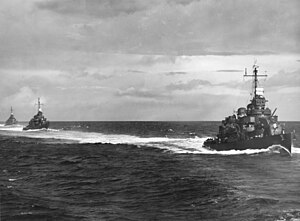Battle off Horaniu
This article includes a list of general references, but it lacks sufficient corresponding inline citations. (September 2014) |
| Battle off Horaniu | |||||||
|---|---|---|---|---|---|---|---|
| Part of the Pacific Theater of World War II | |||||||
 U.S. destroyers (from right to left): O'Bannon, Chevalier, and Taylor head towards Tulagi harbor in the Solomon Islands on 15 August 1943, two days before engaging in the Battle off Horaniu. | |||||||
| |||||||
| Belligerents | |||||||
|
|
| ||||||
| Commanders and leaders | |||||||
|
|
| ||||||
| Strength | |||||||
| 4 destroyers |
4 destroyers, 20 barges and auxiliary ships | ||||||
| Casualties and losses | |||||||
| None |
4 auxiliary ships sunk, 2 destroyers slightly damaged[1] | ||||||
The Battle off Horaniu (Japanese: 第一次ベララベラ海戦) was a minor naval battle of the Pacific campaign of World War II fought on the night of 17 August 1943 near the island of Vella Lavella in the Solomon Islands
Background
After the fall of Munda and their defeat in the Battle of Vella Gulf, the Japanese had decided to evacuate their garrisons in the central Solomons. An evacuation convoy escorted by four destroyers (Sazanami, Hamakaze, Isokaze, and Shigure) commanded by Rear Admiral Matsuji Ijuin set out from its staging base at Horaniu on the northern tip of Vella Lavella on 17 August to evacuate the island of Kolombangara to the east.
Battle
At about 23:30 they were attacked by planes and were still in some disorganization when they were spotted at 00:29 by an American force of four destroyers (USS Nicholas, O'Bannon, Taylor, and Chevalier) commanded by Captain Thomas J. Ryan. After an ineffective exchange of torpedoes and gunfire at long range, the Japanese retreated at about 01:00.
Aftermath
The Japanese saved their barges and were subsequently able to evacuate 9,000 troops from Kolombangara.
Notes
- ^ Morison, Breaking the Bismarcks, p. 236. Ships sunk included two subchasers, two motor torpedo boats, and one powered barge with an unknown number of personnel killed or injured.
References
- D'Albas, Andrieu (1965). Death of a Navy: Japanese Naval Action in World War II. Devin-Adair Pub. ISBN 0-8159-5302-X.
- Dull, Paul S. (1978). A Battle History of the Imperial Japanese Navy, 1941-1945. Naval Institute Press. ISBN 0-87021-097-1.
- Hara, Tameichi (1961). Japanese Destroyer Captain. New York & Toronto: Ballantine Books. ISBN 0-345-27894-1.
- Kilpatrick, C. W. (1987). Naval Night Battles of the Solomons. Exposition Press. ISBN 0-682-40333-4.
{{cite book}}: Cite has empty unknown parameter:|coauthors=(help) - Morison, Samuel Eliot (1958). Breaking the Bismarcks Barrier, vol. 6 of History of United States Naval Operations in World War II. Castle Books. ISBN 0-7858-1307-1.
{{cite book}}: Cite has empty unknown parameter:|coauthors=(help) - Roscoe, Theodore (1953). United States Destroyer Operations in World War Two. Naval Institute Press. ISBN 0-87021-726-7.
{{cite book}}: Cite has empty unknown parameter:|coauthors=(help)
